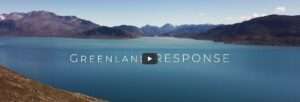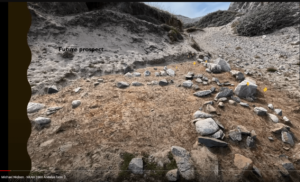The RESPONSE Early Inuit (REI) is a work package under the RESPONSE Project ( NSF title “Coproduction of Knowledge and the building of local archaeological capacity in Greenland”; Arctic Social Sciences Program 1821284) under the direction of Co-PI Christian Koch Madsen, Greenland National Museum & Archives (NKA) that investigates Early Inuit (also referred to as Thule culture) archaeology in South Greenland. REI is carried out in close partnership with the Activating Arctic Heritage (AAH) Project. 2019-24, a Carlsberg Semper Ardens project co-owned by the national museums of Denmark and Greenland. Within the framework of the AAH, C.K. Madsen directs the work package 3.3. Inuit Landscapes, Arctic Agency (ILAA) that focuses on the Early Inuit archaeology in and around the UNESCO World Heritage Site Kujataa, South Greenland: Norse and Inuit Farming on the edge of the Ice Cap. These two work packages have collaborated closely over the last four years by efficiently cost-sharing research, logistics, post excavation analysis etc.
The aims of the REI-ILAA work packages are also very closely linked in that they have allowed parallel investigation of in two subregions of South Greenland (Figure 1), addressing the following research questions and themes:
- Investigate the understudied Thule and early Inuit archaeology in South Greenland, thereby answering the call of local residents, the Kujataa UNESCO World Heritage Centre, and the UNESCO World Heritage Office to improve the general knowledge and inventory of all cultural periods in the region and the Kujataa World Heritage Area. The generated data is fed directly into the Greenland National Museum’s heritage database Nunniffiit, whereby it also contributes to the national heritage management.
- To identify and investigate heritage sites under direct threat from being destroyed by climate impacts (erosion, increased degradation from higher temperatures and precipitation).
- Built local capacity by involving and training local heritage managers and stakeholders, which has been carried out by the continual participation in field work and outreach by the Kujataa UNESCO World Heritage Office site manager (Aka Simonsen), park ranger (Else “Arnaq” Bjerge Petersen), Greenlandic students from the University of Greenland (Ilisimatusarfik, Michael Nielsen, now MA in archaeology, Birte Olsen, Aka Simonsen, now site manager, and Aarhus University, MA student Avaaraq Bendtsen).
The project has been successful in generating a vast and uniquely uniform dataset consisting of some 2,100 surveyed and georeferenced, archaeological features ranging from all time periods (early Inuit c.75%, Norse c.10%, historic Inuit c.15%), most of the sites (c. 80%) not recorded before. Some 10% of the sites have been precision mapped using drones and/or DPGs and a similar number have been test excavated for assessing the preservation organic remains, collecting samples for 14C-dating, and generating zooarchaeological faunal assemblages.





